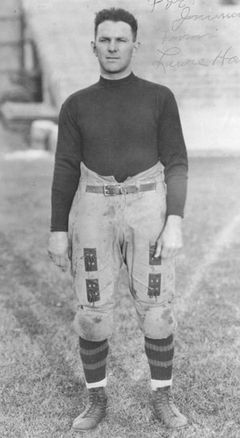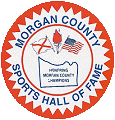2016 INDUCTEE - LEWIS HARDAGE
By David Elwell
Daily Sports Writer
 Believe it or not, there are a few things about Auburn today that were also true in 1908. The town revolved around the college in 1908 like it does today. Only in 1908 the school was called Alabama Polytechnic Institute. Toomer's Drugstore had been in business for 12 years in 1908, but the oak trees at Toomer's Corner didn't come along until 29 years later. Just like today, football was king in 1908. Coach Mike Donahue's Tigers went 6-1 and shared the Southern Intercollegiate Athletic Association championship with LSU. The 1908 Tigers from Auburn had great players making unbelievable plays. One of them was running back Lewis Hardage of Decatur. In a game played in Birmingham on Oct. 24 against powerhouse Sewanee, Hardage returned a punt 45 yards for the only score in the game. The Montgomery Advertiser story about the game called it "Auburn's Greatest Victory in Many Years." Two weeks later at Ponce de Leon Park in Atlanta, Auburn crushed Georgia Tech 44-0. Hardage had two touchdowns against the Yellow Jackets, who were coached by John Heisman. One of Hardage's touchdowns came on a 108-yard kickoff return on a field that was 110-yards long. That's where local historian Bill Dennis enters the picture. One day in 2014 Dennis was online searching through the archives of an Atlanta newspaper. "I can't remember if I was searching for Auburn or Decatur, Alabama," Dennis, an Auburn graduate, said. "I'm reading the story, and there's the mention of this Auburn player from Decatur, Alabama. I had never heard of him."
Believe it or not, there are a few things about Auburn today that were also true in 1908. The town revolved around the college in 1908 like it does today. Only in 1908 the school was called Alabama Polytechnic Institute. Toomer's Drugstore had been in business for 12 years in 1908, but the oak trees at Toomer's Corner didn't come along until 29 years later. Just like today, football was king in 1908. Coach Mike Donahue's Tigers went 6-1 and shared the Southern Intercollegiate Athletic Association championship with LSU. The 1908 Tigers from Auburn had great players making unbelievable plays. One of them was running back Lewis Hardage of Decatur. In a game played in Birmingham on Oct. 24 against powerhouse Sewanee, Hardage returned a punt 45 yards for the only score in the game. The Montgomery Advertiser story about the game called it "Auburn's Greatest Victory in Many Years." Two weeks later at Ponce de Leon Park in Atlanta, Auburn crushed Georgia Tech 44-0. Hardage had two touchdowns against the Yellow Jackets, who were coached by John Heisman. One of Hardage's touchdowns came on a 108-yard kickoff return on a field that was 110-yards long. That's where local historian Bill Dennis enters the picture. One day in 2014 Dennis was online searching through the archives of an Atlanta newspaper. "I can't remember if I was searching for Auburn or Decatur, Alabama," Dennis, an Auburn graduate, said. "I'm reading the story, and there's the mention of this Auburn player from Decatur, Alabama. I had never heard of him."
The story in the Atlanta newspaper described the 5-foot-10, 165-pound Hardage as having "a straight arm that bowled over the best of the Yellow Jackets and then shook off tacklers as though they were flies. He started like a streak, ran with long, high-stepping strides, and covered ground like a bolt of lightning."Dennis' attention turned to finding out more about Hardage. He discovered a story about an amazing man who unfortunately has been all but forgotten by his hometown. "I think he may have been the greatest athlete to ever come out of Decatur," Dennis said. With the help of local historian Phil Wirey and Phil Allison and his staff at the Morgan County Archives, Dennis found that Hardage was born on Feb. 11, 1891. He was one of three children of Monroe and Katy Hardage who lived on Jackson Street between Fourth Avenue and Sixth Avenue.
Lewis was the only one to live to adulthood. His uncle, Alexander, was elected mayor of New Decatur in 1915. How Hardage ended up at Auburn is a mystery. What happened while he was there is not. After the 6-1 record in 1908, the Tigers went 6-2 in 1909. Sewanee got revenge with a 12-11 win. Vanderbilt, maybe the best team in the South that season, won 17-0.
Sometime after the 1909 season, Hardage left Auburn to transfer to Vanderbilt. One report said it was the lure of dental school. More likely it was the lure of playing football for Vanderbilt coaching legend Dan McGugin. After sitting out the 1910 season, Hardage played in 1911 when the Commodores went 8-1. The 1912 team, with Hardage as captain, went 8-1-1. Hardage scored 95 points for the nation's top scoring team. He was named third-team halfback on Walter Camp's All-America team. The first-team halfback was Jim Thorpe of Carlisle College.
After closing out his playing career with a 28-5-1 record, Hardage went into coaching. In 1922 he returned to Vanderbilt as an assistant coach. He was one of two assistant coaches on McGugin's staff. The other assistant was Wallace Wade, who left in 1923 to become head coach at Alabama, where his teams won national championships in 1925, 1926 and 1930.
Hardage became head coach at Oklahoma in 1932. After the Sooners hired Hardage, it was reported that he said his friend Wade had recommended him as his replacement at Alabama when he left for Duke in 1930. Before taking the Oklahoma job, Hardage had agreed to become head coach at LSU earlier in 1932, but Louisiana Gov. Huey Long vetoed the hire and the job went to Biff Jones from Army. The Oklahoma situation was a difficult one to step into. Bennie Owen went 122-54 in 22 seasons before stepping aside in 1926. His successor, Adrian Lindsey, went 19-19 in four seasons before he resigned. "I know what the Oklahoma people want, a football team they can be proud of even in defeat," Hardage told an Oklahoma City newspaper.
 "If hard work will make that kind of team, I'll give it to them." The Sooners went 4-4-1 in 1932 after opening at 3-1. Two losses at the end of the 1933 season gave the Sooners another 4-4-1 record. The 1934 season would be Hardage's last at Oklahoma. The Sooners went 3-4-2 despite allowing just 43 points that season. Hardage may have not been a success as a head coach, but he was definitely a man ahead of his time. In 1927, he patented football pants that were lighter and offered more protection. The design of the pants is similar to what players wear today.
"If hard work will make that kind of team, I'll give it to them." The Sooners went 4-4-1 in 1932 after opening at 3-1. Two losses at the end of the 1933 season gave the Sooners another 4-4-1 record. The 1934 season would be Hardage's last at Oklahoma. The Sooners went 3-4-2 despite allowing just 43 points that season. Hardage may have not been a success as a head coach, but he was definitely a man ahead of his time. In 1927, he patented football pants that were lighter and offered more protection. The design of the pants is similar to what players wear today.
During his three seasons at Oklahoma, Hardage wrote a paper titled "Playing The Backfield."
He described aspects of the game like the art of the stiff arm and how to dodge defenders. The man, who found football stardom in 1908, wrote about it in the 1930s as if he knew what the game would be like in 2016. "Speed in the execution of plays is very important. Line up as quickly as possible, be off in a hurry. Quarterback should give signals as soon as the ball hits the ground, line up and be off again. You will find that opponents quickly become demoralized if plays are run faster than they are used to seeing them run off, especially if you are gaining ground." Hardage was an assistant at Furman in 1935. He was at Florida in 1936. From 1937-1939 he was head baseball coach at Florida. After 1939, not much is known about Hardage. He was known to live in Meridian, Mississippi, in 1953. When he died at age 82 in 1973, he and his wife Vera were living in Melrose, Florida. She died in 1991. They had no children, and Hardage has no known relatives in the Decatur area.
